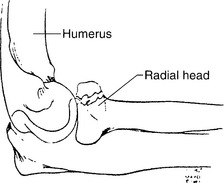Elbow Fracture (Radial Head)
Common signs and symptoms
• Visible deformity if the fracture is complete and bone fragments separate enough to distort normal body contours (rare)
Preventive measures
• Maintain a conditioning routine that includes cardiovascular fitness, elbow and arm strength, flexibility, and endurance training.
Possible complications
• Excessive bleeding in the elbow or at the fracture site, causing pressure and injury to nerves and blood vessels (rare)
• Unstable or arthritic joint following repeated injury, misalignment of the joint surface, or delayed treatment
Medication
• Nonsteroidal antiinflammatory medications, such as aspirin and ibuprofen (do not take for 7 days before surgery), or other minor pain relievers, such as acetaminophen, are often recommended. Take these as directed by your physician, and contact your doctor immediately if any bleeding, stomach upset, or signs of an allergic reaction occur.
• Strong pain relievers may be prescribed as necessary. Use these only as directed, and take only as much as you need.
When to call your doctor
• Any of the following occur after surgery: fever, increased pain, swelling, redness, drainage, or bleeding in the surgical area.
Stay updated, free articles. Join our Telegram channel

Full access? Get Clinical Tree




 supination
supination




